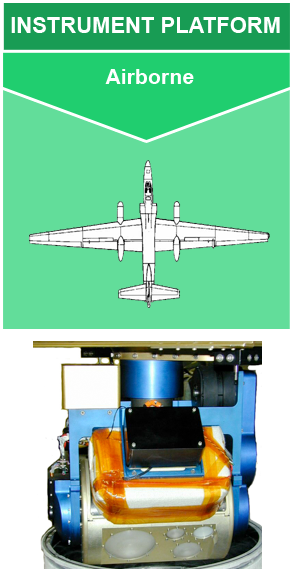Instrument: Conical Scanning Millimeter-wave Imaging Radiometer (CoSMIR)
CoSMIR measures microwave brightness temperatures at 9 microwave frequencies between 50 to 183 GHz. With two in-flight external calibration targets at cruising altitude (one heated to 328 K, and the other maintained at ambient temperature), the data have an accuracy of ±1 K.

| RANGE OF MICROWAVE FREQUENCIES | FOOTPRINT AT 11.8 KM AIRCRAFT ALTITUDE | SAMPLING FREQUENCY | IN-FLIGHT EXTERNAL CALIBRATION TARGETS | ACCURACY |
|---|---|---|---|---|
| 50 to 183 GHz |
Conical scan: 1.3 km x 1.9 km
Cross-track scan: 0.8 km x 0.8 km
|
Conical scan: 2 seconds
Cross-track scan: 3 seconds
|
328 K and ambient temperature | ±1 K |
Wang, J. R., G. M. Skofronick-Jackson, M. R. Schwaller, C. M. Johnson, W. B. Monosmith, and Z. Zhang (2013). Observations of Storm Signatures by the Recently Modified Conical Scanning Millimeter-Wave Imaging Radiometer. IEEE Trans. Geosci. Remote Sens., 51(1), 411-424. doi: https://doi.org/10.1109/TGRS.2012.2200690
Wang, J. R., P. E. Racette, J. E. Piepmeier, B. Monosmith, and W. Manning (2007). Airborne CoSMIR Observations Between 50 and 183 GHz over Snow-Covered Sierra Mountains. IEEE Trans. Geosci. Remote Sens., 45(1), 55-61. doi: https://doi.org/10.1109/TGRS.2006.885410
Wang, J. R., P. E. Racette, and J. R. Piepmeier (2008). A comparison of Near Concurrent Measurements from the SSMIS and CoSMIR for some Selected Channels over the Frequency Range of 50-183 GHz. IEEE Trans. Geosci. Remote Sens., 46(4), 923-933. doi: https://doi.org/10.1109/TGRS.2007.904038









